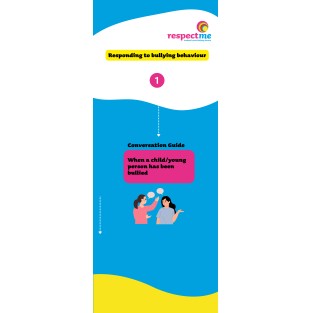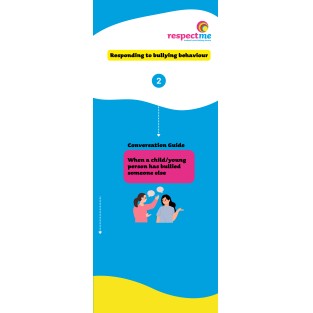Responding to bullying
 When a child or young person tells you they are being bullied, whether it’s happening face to face, online, your reaction is vitally important.
When a child or young person tells you they are being bullied, whether it’s happening face to face, online, your reaction is vitally important.
You don’t need to be a mental health expert to support a child’s wellbeing. Giving a supportive approach, seeking understanding and showing compassion are all things that build a solid relationship with a child and provide the foundation for taking positive actions that help make a difference to children and young people’s lives
Our aim is to give you some practical advice to support children and young people who are being bullied and those who bully others. The way to approach this is through: prevention, response and inclusion.
Bullying is a violation of children’s rights. A key part of our role as adults in offering practical support to children affected by bullying is to ensure a child understands their rights. This is empowering for the child and can be a way to validate their experience and feel confident to claim their rights, in particular with regard to safety.
As adults, we need to make sure that how we respond to bullying respects the rights of the child because when we use a rights-based approach it gives us a mechanism through which a child or young person’s wellbeing can be achieved. We can also be confident that how we are supporting a child or young person preserves the respect and dignity to which all children are entitled.
Active Listening
Young people involved with our Youth Action Group shared experiences of not being taken seriously when they reported bullying to a professional or trusted adult. They felt strongly that adults must champion and uphold young people’s rights to dignity and safety, and to learn and flourish – and for children’s rights to be at the heart of all effective responses to bullying.
Agree a time and place where the child is comfortable to share their experiences. Your initial response will always be that bullying is never acceptable and that you will listen and record everything shared. Staying calm, showing kindness, warmth, compassion and empathy, will validate their feelings and provide reassurance.
Some children may not be open straight away and may take some encouragement to share. You could use cards with feelings and conversation prompts, use photo cards that represent emotions, or allow them to write or draw their feelings as an opener.
Good active listening helps us to understand from the young person, what has happened, the circumstances, how they are being affected and what we can do to help. It also allows them to process the situation, feel a sense of agency and feel valued.
The most effective way to structure your response to bullying to is to ask yourself these questions:
- What was the behaviour?
- What impact did it have?
- What does the child or young person want to happen?
- What do I need to do about it?
- Were there prejudice behaviours or attitudes which need to be addressed?
Children who bully others
Children and young people who are bullying will need help and support to:
- Identify the feelings that cause them to act this way
- Develop alternative ways of responding to these feelings
- Repair relationships
Take time to look at the bigger picture for this person and may be behind the behaviours. We advise against the use of labelling language like calling children ‘bullies’ or ‘bully’. Likewise, avoid using the term ‘victim’ as it can disempower and may have a lifelong impact on the person experiencing bullying. Bullying behaviour is something people do, it isn’t who they are.
When speaking to a child who has bullied others, describe what their behaviour was and why it was wrong. This allows you to be clear about the behaviour that needs to change and to describe the behaviour that you would like to see instead.
Be prepared to address prejudiced attitudes that may be behind the behaviour. Bullying behaviour can often be rooted in prejudice due to difference or perceived difference. It’s important to address what attitudes or beliefs underline the behaviour, even when they bullying has stopped.
Help and further guidance can be sought from a range of partners who can provide information and support around prejudice and protected characteristics. You may deal with the name calling or threats and have strategies in place to respond but we must also respond to the prejudice. Threatening or prejudice-based language or behaviour must always be challenged, even if there is no impact on the person or group it is aimed at.
Resilience
Children and young people will react to bullying in different ways. For some, bullying behaviour will have minimal impact, but for others the impact might be quite severe.
They can be more resilient than we know, however bullying and trauma can strip away at resilience, making it hard for them to talk about it, look for help and cope with the impacts.
Children and young people value secure relationships around them, as well as adults who set boundaries, provide guidance and role model positive behaviour.
You can help children and young people by promoting the wellbeing indicators (SHANARRI):
- Safe: Having a trusted adult to go to if feeling worried or anxious.
- Healthy: Ensuring sleep, diet, exercise and social connections are stable.
- Achieving: Helping them discover or remember their strengths.
- Nurtured: Having positive peer and adult relationships around them.
- Active: Using sport, dance and other hobbies to express pent up feelings and manage stress.
- Respected: Being given love, praise and recognition which builds self-belief, optimism and a sense of purpose.
- Responsible: Being around adults who provide guidance and are good role models.
- Included: Having choices, a say, and a sense of belonging.
Conversation guides
We have created three helpful guides to support a conversation with a child or young person:
Resources and tools
Policy though to Practice: This publication can help you to create a new robust anti-bullying policy.
Learning Academy: Learn more about bullying and responding to bullying by registering for respectme’s free eLearning courses.
respectme reward: Review and celebrate the successful anti-bullying work taking place in your school or setting by following our five stage online toolkit. To apply for a respectme reward you must evidence that you have a current anti-bullying policy, written within the last three years, which reflects your local authority guidance if appropriate, and/or the principles set out in Respect for All – Scotland’s anti-bullying guidance.
Campaigns and resources: We have collated our campaign resources and activities into one helpful space to help you plan informed anti-bullying conversations and lesson plans.


